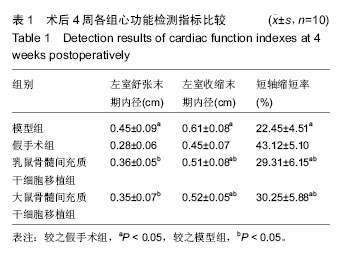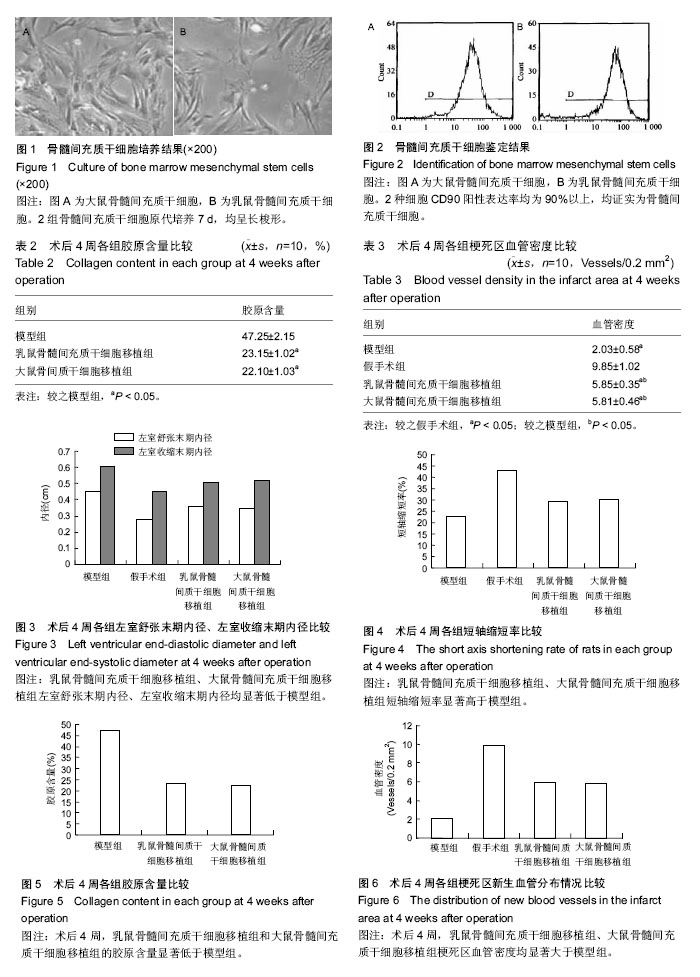| [1] 陈洁,王建安,胡新央,等.同种异体移植骨髓间质干细胞治疗大鼠心梗后心室重构[J].中国病理生理杂志,2007, 23(7): 1267-1271.[2] 张东伟,陈岩,李旭,等.骨髓间质干细胞在心肌梗死治疗中的研究进展[J].心脑血管病防治,2015,15(2):142-144.[3] 杨振儒,翟俊霞.骨髓间质干细胞移植治疗急性心肌梗死研究进展[J].河北医药,2010,32(17):2417-2419.[4] 喻锦扬.黄芪甲苷定向诱导骨髓间充质干细胞分化为心肌样细胞的研究[D].广州中医药大学,2007.[5] 朱红,宋湘,金丽娟,等.自体骨骼肌成肌细胞和骨髓间充质干细胞移植对心肌梗死兔心室重构和心功能的影响[J].心血管康复医学杂志,2011,20(5):400-404.[6] 朱洪生,黄日太,连锋,等.骨髓间质干细胞移植对香猪急性心肌梗死后心肌结构和心功能的影响[J].中国胸心血管外科临床杂志,2004,11(2):112-115.[7] 徐迎佳,吴卫华,黄日太,等.骨髓间质干细胞移植对急性心肌梗死模型香猪心室重构的影响研究[J].中国药房,2006, 17(6):420-422.[8] 陈嘉榆,张祥忠,钟雪云,等.骨髓间质干细胞促进急性心肌梗死大鼠的血管新生及其抗纤维化作用[J].广东医学, 2008,29(10):1639-1641.[9] 王建安,谢小洁,孙勇,等.骨髓间质干细胞冠脉内移植治疗近期陈旧性心肌梗死伴心功能不全[J].中华急诊医学杂志,2005,14(12):996-999.[10] 章敬水,吴继雄,杨宇辉,等.经静脉移植骨髓间质干细胞对急性心肌梗死大鼠心功能的影响[J].山东医药,2009, 49(9):31-33.[11] 何卫中,李颖则,沙慧芳,等.骨髓间质干细胞移植治疗大鼠急性心肌梗死的病理学观察[J].中国组织工程研究与临床康复,2007,11(3):486-489,后插页4.[12] 杨敏,吴贤仁,李玉光,等.骨髓间质干细胞与心肌再生[J].中国急救医学,2003,23(7):479-480.[13] 马国涛,任华,朱朝晖,等.骨髓间质干细胞移植治疗兔缺血性心脏病[J].基础医学与临床,2009,29(3):273-276.[14] 田新桥,钱蕴秋,张军,等.自体骨髓间质干细胞移植对兔心肌梗死左心室收缩功能的作用[J].中华超声影像学杂志, 2005,14(4):307-309.[15] 孙晓楠,刘国树,石蕊,等.骨髓间质干细胞移植对自发性高血压大鼠心脏纤维化及心功能的影响[J].高血压杂志, 2005,13(2):109-113.[16] Shim WS, Tan G, Gu Y, et al. Dose-dependent systolic contribution of differentiated stem cells in post-infarct ventricular function. J Heart Lung Transplant. 2010; 29(12):1415-1426.[17] 方志坚,陈伯钧,刘泉颖,等.通冠胶囊联合自体骨髓间质干细胞移植对心肌梗死后大鼠心功能的影响[C].//首届全国中西医结合重症医学学术会议暨中国中西医结合学会重症医学专业委员会成立大会论文集,2010:343-346.[18] 张瑶,李永利,李丽丽,等.骨髓间质干细胞移植对心力衰竭大鼠心室重构影响的实验研究[J].中华心血管病杂志, 2009,37(4):347-351.[19] Liu YL, Zhou Y, Sun L, et al. Protective effects of Gingko biloba extract 761 on myocardial infarction via improving the viability of implanted mesenchymal stem cells in the rat heart. Mol Med Rep. 2014;9(4):1112- 1120.[20] 朱刚艳,徐红新,田毅浩,等.曲美他嗪改善骨髓间质干细胞在大鼠体外缺氧模型和体内心肌梗死模型中的存活和分化作用[J].中国循环杂志,2011,26(5):386-389.[21] 朱刚艳,徐红新,田毅浩,等.曲美他嗪联合骨髓间质干细胞移植治疗急性心肌梗死的实验研究[J].重庆医学, 2012, 41(11):1096-1099,后插2,封3.[22] 钟泽,胡家庆,孙勇,等.myocardin相关转录因子-A在骨髓间质干细胞治疗心肌梗死中对bcl-2基因的调控作用[J].中华心血管病杂志,2015,43(6):531-536.[23] Lu M, Liu S, Zheng Z, et al. A pilot trial of autologous bone marrow mononuclear cell transplantation through grafting artery: A sub-study focused on segmental left ventricular function recovery and scar reduction. Int J Cardiol. 2013;168(3):2221-2227.[24] Houtgraaf JH, De Jong R, Kazemi K, et al. Intracoronary infusion of allogeneic mesenchymal precursor cells directly after experimental acute myocardial infarction reduces infarct size, abrogates adverse remodeling, and improves cardiac function. Circ Res. 2013;113(2):153-166.[25] Huang CC, Tsai HW, Lee WY, et al. A translational approach in using cell sheet fragments of autologous bone marrow-derived mesenchymal stem cells for cellular cardiomyoplasty in a porcine model. Biomaterials. 2013;34(19):4582-4591.[26] 杨新春,易方方,蔡军,等.由胚胎干细胞分化的心肌细胞移植对心肌梗死大鼠左心室重构及心功能的影响[J].中华器官移植杂志,2007,28(9):530-533.[27] 黄日太,朱洪生,薛松,等.骨髓MSCs移植对急性心肌梗死后心室肌重构和心功能的影响[J].上海交通大学学报(医学版),2008,28(4):359-362.[28] 陈柯,沈振亚,余云生,等.自体干细胞动员对缺血性心肌病炎症变化及心室重构影响的研究[C].//第六届全国再生医学(干细胞与组织工程)学术研讨会暨第三届中华医学会医学工程学分会干细胞工程专业委员会年会论文集, 2010:21-33.[29] 陈柯,祝晓,郭勇,等.自体干细胞动员对缺血性心肌病炎症变化及心室重构影响的研究[C].//第四届全国再生医学(干细胞与组织工程)学术研讨会暨全国人体干细胞移植技术临床应用管理高层研讨会、第一届中华医学会医学工程学分会干细胞工程专业委员会学术年会论文集, 2008:74-84.[30] 林玲,周胜华,祁述善,等.粒细胞集落刺激因子和干细胞因子对急性心肌梗死后心室重构的影响[J].中国介入心脏病学杂志,2005,13(3):178-181.[31] 邓鹏,沈振亚.自体骨髓干细胞动员抑制急性心肌梗死后心室重构的研究[C].//第六届全国再生医学(干细胞与组织工程)学术研讨会暨第三届中华医学会医学工程学分会干细胞工程专业委员会年会论文集,2010:169-176.[32] 黄国倩,刘虹,舒先红,等.超声心动图评价粒细胞集落刺激因子动员自身骨髓干细胞对心肌梗死后左心室重构及心功能的影响[J].中华超声影像学杂志,2004,13(11):848- 852.[33] Arsalan M, Dhein S, Aupperle H, et al. The reverse remodeling effect of mesenchymal stem cells is independent from the site of epimyocardial cell transplantation. Innovations (Phila). 2013;8(6): 433-439.[34] Umar S,de Visser YP,Steendijk P, et al. Allogenic stem cell therapy improves right ventricular function by improving lung pathology in rats with pulmonary hypertension. Am J Physiol Heart Circ Physiol. 2009; 297(5 Pt.2):H1606-H1616.[35] Novotny NM, Ray R, Markel TA, et al.Stem Cell Therapy in Myocardial Repair and Remodeling.J Am Coll Surg. 2008;207(3):423-434.[36] 陈洁,王建安,骆荣华,等.骨髓间充质干细胞移植对大鼠心肌梗死后心室重构的影响[J].中华急诊医学杂志,2006, 15(4):310-314.[37] 林茂海,苏津自,许昌声,等.肾上腺髓质素基因转染增强骨髓间充质干细胞移植对心肌梗死大鼠心室重构及心功能的影响[J].中国病理生理杂志,2009,25(9):1692-1699. |
.jpg)



.jpg)